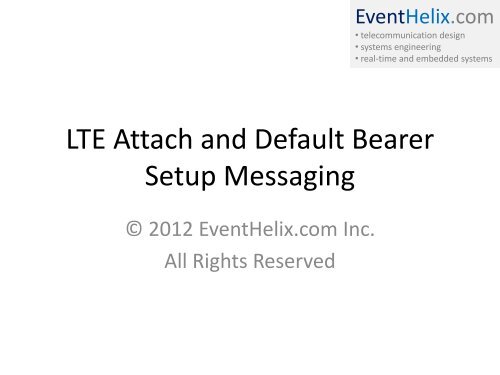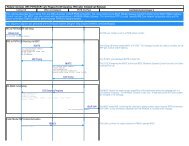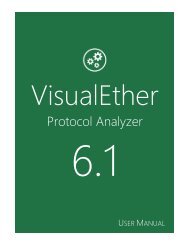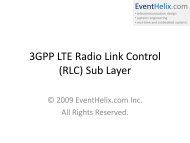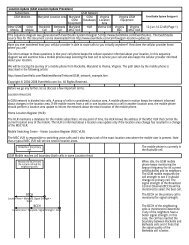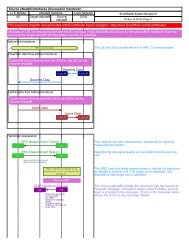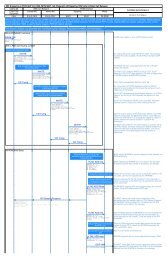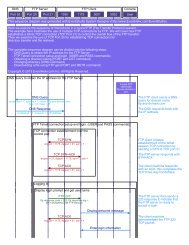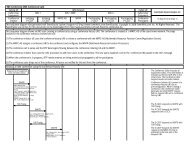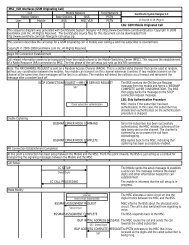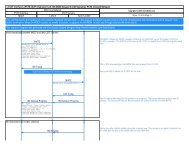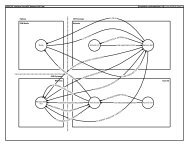LTE Attach and Default Bearer Setup - EventHelix.com
LTE Attach and Default Bearer Setup - EventHelix.com
LTE Attach and Default Bearer Setup - EventHelix.com
You also want an ePaper? Increase the reach of your titles
YUMPU automatically turns print PDFs into web optimized ePapers that Google loves.
<strong>EventHelix</strong>.<strong>com</strong><br />
• tele<strong>com</strong>munication design<br />
• systems engineering<br />
• real-time <strong>and</strong> embedded systems<br />
<strong>LTE</strong> <strong>Attach</strong> <strong>and</strong> <strong>Default</strong> <strong>Bearer</strong><br />
<strong>Setup</strong> Messaging<br />
© 2012 <strong>EventHelix</strong>.<strong>com</strong> Inc.<br />
All Rights Reserved
<strong>LTE</strong> <strong>Attach</strong> Message<br />
Sequence Chart<br />
<strong>EventHelix</strong>.<strong>com</strong><br />
• tele<strong>com</strong>munication design<br />
• systems engineering<br />
• real-time <strong>and</strong> embedded systems<br />
eNodeB MME SGW HSS<br />
Initial UE Message<br />
Update Location Request<br />
Update Location Answer<br />
Create Session Request<br />
Create Session Response<br />
Initial Context <strong>Setup</strong> + <strong>Attach</strong> Accept +<br />
Activate <strong>Default</strong> <strong>Bearer</strong><br />
Initial Context <strong>Setup</strong> Response<br />
<strong>Attach</strong> Complete + Activate <strong>Default</strong> <strong>Bearer</strong> Accept<br />
Modify <strong>Bearer</strong> Request<br />
© 2012 <strong>EventHelix</strong>.<strong>com</strong> Inc.<br />
2
S1AP Initial UE Message<br />
S1AP: eNodeB MME<br />
S1AP Initial UE Message<br />
Id: eNB UE S1AP ID<br />
<strong>EventHelix</strong>.<strong>com</strong><br />
• tele<strong>com</strong>munication design<br />
• systems engineering<br />
• real-time <strong>and</strong> embedded systems<br />
• Initial UE Message is the first<br />
message sent to the MME to<br />
establish a connection<br />
Tracking Area Id<br />
Tracking Area Code<br />
Cell Id<br />
• The eNode uses the eNB-UE-S1AP-<br />
ID to uniquely identify the UE<br />
• EPS attach type may be:<br />
• EPS <strong>Attach</strong>: UE is attaching only<br />
to the 4G <strong>LTE</strong> network<br />
• Combined EPS/IMSI <strong>Attach</strong>:<br />
• The UE identity is specified is:<br />
• IMSI: If the UE has is not<br />
registered with the network<br />
• Old GUTI: Subsequent attach<br />
requests identify the UE with the<br />
Old GUTI<br />
<strong>Attach</strong> Request<br />
EPS attach type<br />
Identity<br />
EPS Encryption<br />
Algorithm Supported<br />
EPS Integrity<br />
Algorithm Supported<br />
EPS <strong>Attach</strong><br />
Combined EPS/IMSI<br />
<strong>Attach</strong><br />
IMSI<br />
Old GUTI<br />
PDN Type: IPV4<br />
Connection Request<br />
Type: Initial <strong>Attach</strong><br />
© 2012 <strong>EventHelix</strong>.<strong>com</strong> Inc. 3
Diameter Update Location<br />
Request<br />
S6A: MME HSS<br />
Diameter Update Location<br />
Request<br />
• MME updates the UE location with<br />
the HSS<br />
• Origin <strong>and</strong> Destination are<br />
specified as Host <strong>and</strong> Realm<br />
(domain)<br />
• The user name in the request is set<br />
to IMSI<br />
• The Radio Access Technology is<br />
specified in the RAT Type<br />
• It will be set to EUTRAN for <strong>LTE</strong><br />
access<br />
• The Visited PLMN is also included<br />
in the message<br />
Comm<strong>and</strong> Code<br />
Application Id<br />
Origin<br />
Destination<br />
User Name<br />
<strong>EventHelix</strong>.<strong>com</strong><br />
• tele<strong>com</strong>munication design<br />
• systems engineering<br />
• real-time <strong>and</strong> embedded systems<br />
Update Location<br />
Request<br />
S6a interface<br />
application<br />
Host<br />
Realm<br />
Host<br />
Realm<br />
IMSI<br />
RAT Type<br />
EUTRAN<br />
MCC<br />
Visited PLMN Id<br />
MNC<br />
© 2012 <strong>EventHelix</strong>.<strong>com</strong> Inc. 4
Diameter Update Location<br />
Answer<br />
S6A: MME HSS<br />
Diameter Update Location<br />
Answer<br />
• The HSS accesses the database <strong>and</strong><br />
responds with user information to the<br />
MME<br />
• The Aggregate Maximum Bit Rate (AMBR)<br />
occurs twice in the message:<br />
• The first occurrence specifies the<br />
maximum bit rate for the default PDP<br />
context<br />
Result Code: Success<br />
Subscriber Status:<br />
Service Granted<br />
Aggregate Maximum<br />
Bit Rate<br />
Access Restriction<br />
Data<br />
MSISDN<br />
<strong>EventHelix</strong>.<strong>com</strong><br />
• tele<strong>com</strong>munication design<br />
• systems engineering<br />
• real-time <strong>and</strong> embedded systems<br />
Maximum Requested<br />
B<strong>and</strong>width Uplink<br />
Maximum Requested<br />
B<strong>and</strong>width Downlink<br />
Called Station Id<br />
PDN Type<br />
IPV4<br />
• The second occurrence specifies the data<br />
maximum data limit via the APN. These<br />
limits are specified by the PDN<br />
• APN configuration also includes:<br />
• IP address of the PDN Gateway. This<br />
address is used to determine the default<br />
route for the traffic towards the Internet<br />
APN Configuration<br />
Profile<br />
PDN GW Address<br />
PDN GW Name<br />
QoS Class Identifier<br />
QCI specifies BER,<br />
Priority, GBR<br />
• IP address assigned to the UE (Served<br />
Party IP Address)<br />
Served Party IP<br />
Address<br />
3GPP Charging<br />
Characteristics<br />
Aggregate Maximum<br />
Bit Rate<br />
Maximum Requested<br />
B<strong>and</strong>width Uplink<br />
Maximum Requested<br />
B<strong>and</strong>width Downlink<br />
© 2012 <strong>EventHelix</strong>.<strong>com</strong> Inc. 5
<strong>Default</strong> <strong>Bearer</strong><br />
Establishment<br />
<strong>EventHelix</strong>.<strong>com</strong><br />
• tele<strong>com</strong>munication design<br />
• systems engineering<br />
• real-time <strong>and</strong> embedded systems<br />
MME SGW:<br />
Create Session<br />
Request<br />
SGW PGW:<br />
Create Session<br />
Request<br />
•The SGW asks<br />
the PGW to<br />
establish the<br />
bearer<br />
SGW PGW:<br />
Create Session<br />
Response<br />
•The PGW<br />
establishes the<br />
bearer <strong>and</strong><br />
responds back to<br />
the SGW<br />
MME SGW:<br />
Create Session<br />
Response<br />
• The SGW<br />
responds<br />
back to the<br />
MME<br />
© 2012 <strong>EventHelix</strong>.<strong>com</strong> Inc. 6
GTP Create Session Request<br />
S11: MME SGW<br />
GTP Create Session<br />
Request<br />
IMSI<br />
RAT Type<br />
EUTRAN<br />
TEID<br />
<strong>EventHelix</strong>.<strong>com</strong><br />
• tele<strong>com</strong>munication design<br />
• systems engineering<br />
• real-time <strong>and</strong> embedded systems<br />
• MME initiates the default route<br />
establishment by asking the SGW<br />
to create a GTP tunnel<br />
Sender F-TEID for<br />
Control Plane<br />
MME IP Address<br />
EPS <strong>Bearer</strong> Id<br />
• The source is identified by the fully<br />
qualified endpoint identifier with<br />
the Tunnel Endpoint Identifier<br />
(TEID) <strong>and</strong> the MME IP Address<br />
• The IP Address assigned to the UE<br />
is also included along with the<br />
downlink <strong>and</strong> uplink maximum<br />
data rates allowed at the APN level<br />
PDN Type<br />
<strong>Bearer</strong> Context<br />
MSISDN<br />
TAI<br />
IPV4 OR IPV6<br />
ARP<br />
QCI<br />
MCC, MNC, TAC<br />
QCI specifies BER,<br />
Priority, GBR<br />
• The TAI <strong>and</strong> ECGI (E-UTRAN Cell<br />
Group Identifier) information<br />
identify the current location of the<br />
user<br />
ECGI Contents<br />
PGW S5/S9<br />
Address for Control<br />
MCC, MNC, ECI<br />
TEID<br />
PGW IP Address<br />
PDN IP Address<br />
APN<br />
PDN Address<br />
Allocation<br />
IP Address<br />
Assigned to UE<br />
Aggregate Max Bit<br />
Rate APN Limit<br />
Downlink <strong>and</strong><br />
Uplink<br />
© 2012 <strong>EventHelix</strong>.<strong>com</strong> Inc. 7
Initial Context Request / <strong>Attach</strong><br />
Accept/ <strong>Default</strong> <strong>Bearer</strong> Request<br />
S1AP: eNodeB MME<br />
S1AP Initial Context <strong>Setup</strong> Request<br />
NAS <strong>Attach</strong> Accept<br />
Activate <strong>Default</strong> <strong>Bearer</strong> Request<br />
<strong>EventHelix</strong>.<strong>com</strong><br />
• tele<strong>com</strong>munication design<br />
• systems engineering<br />
• real-time <strong>and</strong> embedded systems<br />
The next message from the MME is<br />
really a three-in-one. The message<br />
contains:<br />
• SIAP Initial Context <strong>Setup</strong> Request<br />
• A request to establish a context<br />
between the MME <strong>and</strong> eNodeB<br />
• The message contains SGW<br />
tunneling information<br />
• NAS <strong>Attach</strong> Accept<br />
• This message acknowledges the<br />
successful <strong>Attach</strong> to the UE.<br />
• The eNodeB will pass this<br />
message to the UE<br />
• Activate <strong>Default</strong> <strong>Bearer</strong> Request<br />
• The message initiates the default<br />
bearer setup on the UE<br />
• The eNodeB will pass this<br />
message to the UE<br />
S1AP PDU<br />
EPS mobility<br />
management messages<br />
EPS session<br />
management messages<br />
S1AP Initial Context<br />
<strong>Setup</strong> Request<br />
NAS <strong>Attach</strong> Accept<br />
Activate <strong>Default</strong> <strong>Bearer</strong><br />
Request<br />
© 2012 <strong>EventHelix</strong>.<strong>com</strong> Inc. 8
SIAP Initial Context <strong>Setup</strong><br />
Request<br />
S1AP: eNodeB MME<br />
S1AP Initial Context <strong>Setup</strong><br />
Request<br />
• The MME responds with MME UE<br />
S1AP ID that was received from<br />
the eNodeB in the initial UE<br />
message<br />
• The message also contains the<br />
MME UE S1AP ID<br />
• The message contains the<br />
maximum aggregate bit rate<br />
information.<br />
• The message also contains the<br />
information about the default<br />
eRAB.<br />
• QCI to assign session priority<br />
• The maximum bit rate for the<br />
eRAB<br />
• Guaranteed bit rate for the eRAB<br />
• Transport Layer Address assigns<br />
the IP Address for the user plane<br />
entity on the S-GW<br />
• GTP TE ID identifies the S-GW<br />
end of the user plane tunnel<br />
• The security capabilities specify<br />
the encryption <strong>and</strong> integrity<br />
protection algorithm to be used<br />
for the UE session<br />
MME UE S1AP ID<br />
ENB UE S1AP ID<br />
Aggregate Max<br />
Bitrate (AMBR)<br />
eRABs to <strong>Setup</strong><br />
UE Security<br />
Capability<br />
Security Key<br />
Downlink<br />
Uplink<br />
eRAB ID<br />
Encryption<br />
Algorithm<br />
Integrity Protection<br />
Algorithm<br />
<strong>EventHelix</strong>.<strong>com</strong><br />
• tele<strong>com</strong>munication design<br />
• systems engineering<br />
• real-time <strong>and</strong> embedded systems<br />
QCI<br />
eRAB Max Bit Rate<br />
Downlink<br />
eRAB Max Bit Rate<br />
Uplink<br />
RAB Guaranteed Bit<br />
Rate Downlink<br />
RAB Guaranteed Bit<br />
Rate Uplink<br />
Transport Layer<br />
Address<br />
GTP TE ID<br />
© 2012 <strong>EventHelix</strong>.<strong>com</strong> Inc. 9
NAS <strong>Attach</strong> Accept<br />
eNodeB MME<br />
UE eNodeB<br />
NAS <strong>Attach</strong> Accept<br />
<strong>EventHelix</strong>.<strong>com</strong><br />
• tele<strong>com</strong>munication design<br />
• systems engineering<br />
• real-time <strong>and</strong> embedded systems<br />
• The <strong>Attach</strong> Accept is carried as<br />
NAS payload in the Initial Context<br />
<strong>Setup</strong> Request<br />
• The message specifies that the<br />
attach has been successful. The<br />
terminal is attached to the EPS<br />
only (i.e. <strong>LTE</strong> only, no SGSN<br />
registration)<br />
• The T3412 timer specifies the<br />
maximum time between tracking<br />
area updates from the terminal<br />
• The TAI list in the message<br />
specifies the PLMN <strong>and</strong> the<br />
Tracking Area Codes for all the<br />
registered tracking areas<br />
• The message contains GUTI. GUTI<br />
uniquely identifies the UE with<br />
PLMN, MME Group, MMC code<br />
<strong>and</strong> the M-TMSI<br />
• Finally, the GPRS Ready timer is<br />
included in the message.<br />
• The UE will be transitioned to<br />
IDLE if no activity is detected for<br />
this period<br />
EPS <strong>Attach</strong> Result<br />
T3412<br />
TAI List<br />
GUTI<br />
GPRS Ready Timer<br />
EPS Only<br />
Type<br />
Partial TAI List<br />
MCC<br />
MNC<br />
MME Group Id<br />
MME Code<br />
M-TMSI<br />
One PLMN<br />
PLMN<br />
TAC List<br />
© 2012 <strong>EventHelix</strong>.<strong>com</strong> Inc. 10
Activate <strong>Default</strong> <strong>Bearer</strong><br />
Request<br />
eNodeB MME<br />
UE eNodeB<br />
Activate <strong>Default</strong> <strong>Bearer</strong><br />
Request<br />
• The <strong>Attach</strong> Accept is carried as<br />
NAS payload in the Initial Context<br />
<strong>Setup</strong> Request<br />
• The EPS <strong>Bearer</strong> id identifies the<br />
bearer that needs to be activated<br />
• The EPS QoS carries quality of<br />
service information:<br />
• QCI to assign session priority<br />
• The maximum bit rate for the<br />
bearer<br />
• Guaranteed bit rate for the<br />
bearer<br />
• The Access Point Name (APN) is<br />
included in the message<br />
• The PDN IP address assigned by<br />
the HSS is passed to the UE<br />
EPS <strong>Bearer</strong> Id<br />
EPS QoS<br />
Access Point Name<br />
PDN Address<br />
<strong>EventHelix</strong>.<strong>com</strong><br />
• tele<strong>com</strong>munication design<br />
• systems engineering<br />
• real-time <strong>and</strong> embedded systems<br />
QCI<br />
eRAB Max Bit Rate<br />
Downlink<br />
eRAB Max Bit Rate<br />
Uplink<br />
RAB Guaranteed<br />
Bit Rate Downlink<br />
RAB Guaranteed<br />
Bit Rate Uplink<br />
© 2012 <strong>EventHelix</strong>.<strong>com</strong> Inc. 11
S1AP Initial Context <strong>Setup</strong><br />
Response<br />
eNodeB MME<br />
Initial Context <strong>Setup</strong><br />
Response<br />
<strong>EventHelix</strong>.<strong>com</strong><br />
• tele<strong>com</strong>munication design<br />
• systems engineering<br />
• real-time <strong>and</strong> embedded systems<br />
• The eNodeB sends the Initial<br />
Context <strong>Setup</strong> Response message<br />
to the MME.<br />
• The message confirms the<br />
establishment of the GTP tunnel<br />
on the S1-U interface<br />
MME UE S1AP ID<br />
• The message contains information<br />
about the RABs that are being<br />
established at startup.<br />
• The following information is<br />
present for each RAB<br />
eNB UE S1AP ID<br />
E-RAB <strong>Setup</strong> List<br />
E-RAB <strong>Setup</strong> Item<br />
E-RAB ID<br />
Transport Layer<br />
Address<br />
• The E-RAB ID<br />
• The transport layer IP address on<br />
the eNodeB.<br />
GTP TEID<br />
• The eNodeB GTP Tunneling ID<br />
(TEID) for the eNodeB side.<br />
© 2012 <strong>EventHelix</strong>.<strong>com</strong> Inc. 12
Completing the <strong>Attach</strong> <strong>and</strong><br />
<strong>Default</strong> <strong>Bearer</strong> Activation<br />
<strong>EventHelix</strong>.<strong>com</strong><br />
• tele<strong>com</strong>munication design<br />
• systems engineering<br />
• real-time <strong>and</strong> embedded systems<br />
eNodeB MME:<br />
<strong>Attach</strong> Complete<br />
+ Activate <strong>Default</strong><br />
<strong>Bearer</strong> Accept<br />
• eNodeB transports<br />
<strong>Attach</strong> Complete <strong>and</strong><br />
Activate <strong>Default</strong><br />
<strong>Bearer</strong> Accept<br />
• The message was<br />
received from the UE<br />
MME SGW:<br />
Modify <strong>Bearer</strong><br />
Request<br />
• Inform SGW<br />
about the<br />
eNodeB’s user<br />
plane IP address<br />
<strong>and</strong> GTP TEID<br />
© 2012 <strong>EventHelix</strong>.<strong>com</strong> Inc. 13
Thank You<br />
<strong>EventHelix</strong>.<strong>com</strong><br />
• tele<strong>com</strong>munication design<br />
• systems engineering<br />
• real-time <strong>and</strong> embedded systems<br />
Thank you for visiting <strong>EventHelix</strong>.<strong>com</strong>. The following links provide more information<br />
about tele<strong>com</strong> design tools <strong>and</strong> techniques:<br />
Links<br />
EventStudio System Designer<br />
VisualEther Protocol Analyzer<br />
Tele<strong>com</strong> Call Flows<br />
TCP/IP Sequence Diagrams<br />
Tele<strong>com</strong> • Networking • Software<br />
Description<br />
Sequence diagram based systems engineering<br />
tool.<br />
Wireshark based visual protocol analysis <strong>and</strong><br />
system design reverse engineering tool.<br />
GSM, SIP, H.323, ISUP, <strong>LTE</strong> <strong>and</strong> IMS call flows.<br />
TCP/IP explained with sequence diagrams.<br />
Real-time <strong>and</strong> embedded systems, call flows <strong>and</strong><br />
object oriented design articles.<br />
© 2012 <strong>EventHelix</strong>.<strong>com</strong> Inc.<br />
14


